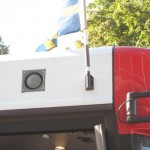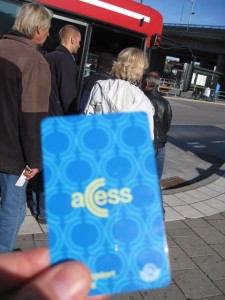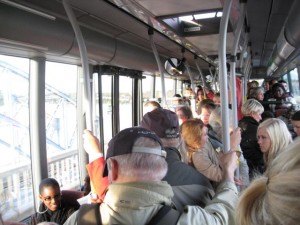Notebook from World Intelligent Transportation Systems Congress
 About two weeks ago, on September 22nd, I spoke at and attended the World ITS Congress in Stockholm, Sweden.
About two weeks ago, on September 22nd, I spoke at and attended the World ITS Congress in Stockholm, Sweden.
Usually, my audience and colleagues are managers, staff, and consultants for rural, small, and mid-sized transportation U.S. transit agencies. Speaking at, and attending an international conference of broad scope was eye-opening.
Here are some highlight observations:
- With regards to transportation, I was far more inspired by the experience of using SL, Stockholm’s public transportation system, than I was by the congress itself. SL demonstrated what I didn’t even know was possible with public transportation. In what is actually the fairly small metro area of Stockholm (roughly 2 million residents, similar to Portland), SL provides service to 750,000 passengers daily (some making multiple trips). Public transit claims approximately 40% transport modeshare. All vehicles are quiet, clean, and fast. Routes operate with very high frequency.
The SL vision and mission statements show some of attitudes, priorities, and goals underpinning these achievements. The vision: “SL brings greater ease and convenience to day-to-day life and contributes to a more attractive Stockholm region.” SL’s mission includes providing attractive public transit. Attractive, as in, “this service attracts me to use it even though I have other options because it is fast, easy, and pleasant to use.” They see static and electronic signage, and online and printed customer information as playing a significant role in making public transportation attractive, though the agency is lagging behind U.S. counterparts in engaging partners to provide this customer information (more later).
- Panelists in my session, “Using Social Networking Websites and Google: New Ways of Attracting Public Transport Riders,” almost all made open data the prominent theme in their presentations and discussion, and without any coordination among panelists beforehand. That’s a sign, I think, of the importance, and growing profile of this topic. The fellow from SL, Elias Arnestrand, who presented after me, gave a very candid and interesting snapshot of where SL is in their thinking and practice of sharing data, and, I think, provided a good window into the mind and approach of many European agencies. He said, essentially, that SL does see partner content providers as an opportunity to provide information to customers in new ways. However, SL has invested significantly in technology to deliver customer information and is reluctant to take steps which they see may compromise that legacy investment. In addition, SL takes providing reliable information very seriously, and so they’re concerned that giving up some of that control may compromise the SL brand and customer experience. However, the reality is that the demand for open data is mounting, and so refusing to take the steps down that path could open the agency to public relations debacles. Essentially, the agency has recognized they have no choice, so they are taking cautious steps towards engaging partners — probably just a few select partners at first, and potentially opening up further if that goes well.
I found the general caution I sensed in Europe around open data interesting in a few ways. It enhanced my appreciation of the Obama administration’s push for open data. I believe the Federal government’s policy is setting the correct tone and encouraging more forward-thinking policy and practice throughout the U.S. I also perceived that European agencies (of all types, not just transportation) are wary to private companies generating revenue off their public data. I tend more to agree with what I think and hope is a prevailing U.S. attitude, which is that this is perfectly legitimate for a private company to earn revenue from using public data, as long as they are providing some additional value from the data as well (and how can they earn revenue if they are not?). A vibrant market and competition in the online transportation information space will help the public more than a public agency making a couple bucks off the sale of data.
What I perceive is happening with European agencies here is somewhat akin to what sometimes happens developed nations as compared to developing nations in the adoption of new technology. Whereas in the U.S. we have billions of dollars invested in old copper-wire communications networks and outdated wireless networks, when a developing nation installs communications networks they are sometimes able to leapfrog the legacy technologies developed nations are saddled with and committed to. European transportation agencies have invested a lot in journey planners and customer information for transit. To embrace an approach with partner content providers probably feels as if they are compromising systems they’re already heavily invested in. Even though public transportation in the U.S. is very far behind Europe, I believe the approach many U.S. transit agencies are beginning to take in embracing third-party developers is more advanced and forward-thinking, and that we’ll see Europe follow along.
- Somewhat disappointing was the World ITS Congress’s strong emphasis on technology for roads and cars, instead of seeing more multi-modal ITS for public transit, and even for bicycle and pedestrian way-finding and infrastructure planning, etc. I guess that’s a sign of the state of things, though. Even with Detroit going bankrupt, the auto-centric way of doing things still has, by far, the most power and largest pot of money.
Here’s the slidedeck from my presentation:
Transit 2.0 – World Intelligent Transportation Systems Congress





